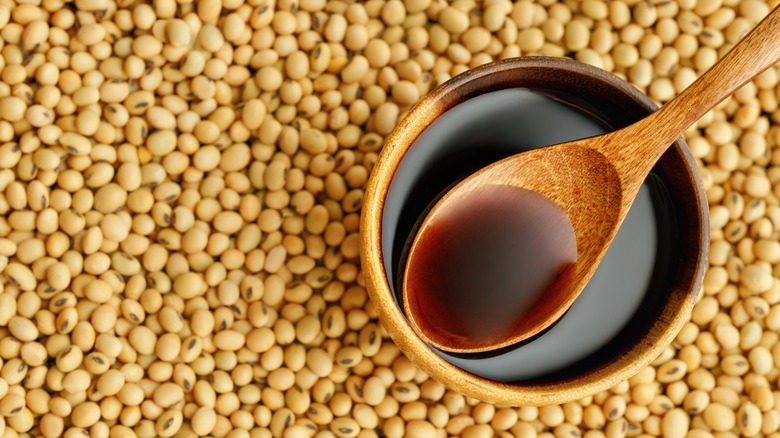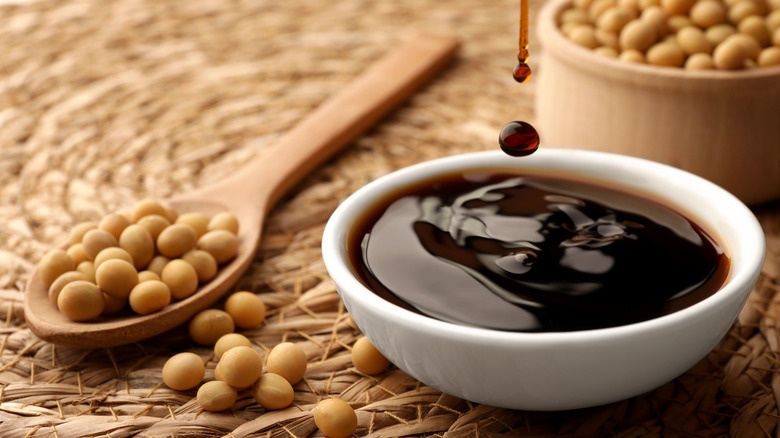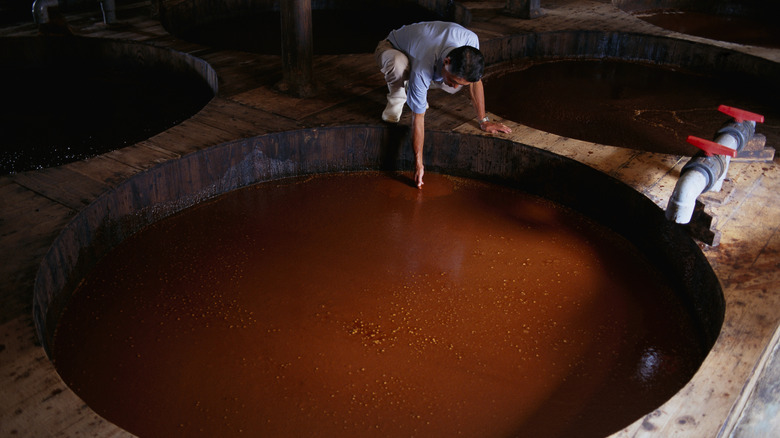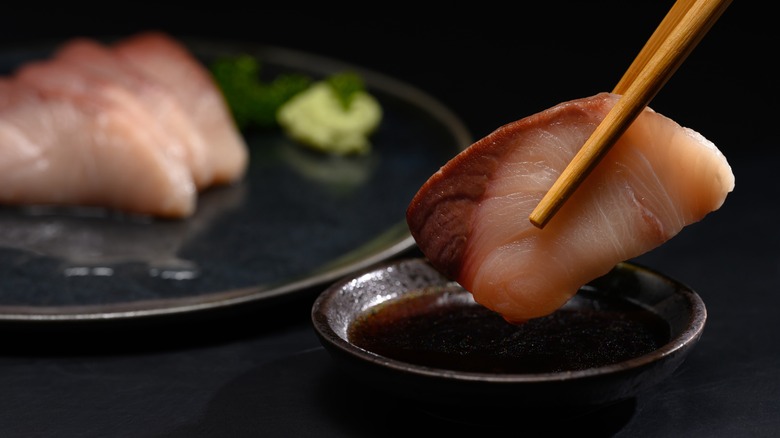What Is The Most Expensive Soy Sauce And How Is It Made?
We may receive a commission on purchases made from links.
For sushi or a veggie stir-fry, it's easy enough to head to most grocery stores and pick up a bottle of soy sauce without glancing at the price tag. Basic ingredients like soybeans, wheat, water, and salt make the base of soy sauce, so it's logical that this seasoning and condiment wouldn't surpass a few dollars. But if you add 38 years of aging and traditional techniques tracing back to the Edo period, you can find yourself looking at a $182 price tag for a 55 ml bottle.
The world's most expensive soy sauce comes from Kamebishi, a soy sauce brewery based in Higashikagawa, Japan, operating since 1753. The brewery was founded by Lord and samurai Iyemon and continues to be owned and operated by his descendants, the Okada family. They are the only soy sauce producer that uses the time-consuming and labor-intensive mushiro koji method — more on what this is this later.
All soy sauce is aged, but typically for only a few months. The umami flavor normally found in soy sauce is amplified after 38 years of aging, resulting in an incredibly rich sauce with woody, toasted, floral, and fruity notes, with some flavors similar to balsamic vinegar. The 18th generation owner of Kamebishi, Kaori Okada, shared in a Business Insider video that the lactic acid fermentation process produces five flavors — sweet, sour, bitter, salty, and umami — and soy sauce is the result of the balance of these flavors.
How 38-year-old soy sauce is made
First, the soybeans are steamed and soaked to soften the hard exterior. Then, they are hand-mixed with a finely ground barley powder inoculated with the Aspergillus oryzae mold — this is called koji. This begins the fermentation process, where the mold breaks down protein and starches in the beans and barley, converting them into sugar and amino acids. The traditional process, the mushiro koji method, which hasn't changed for 260 years, involves laying the koji mixture out on straw mats (mushiro in Japanese) and placed on top of bamboo trays for precisely three days and three nights. The temperature is constantly monitored and adjusted during this time.
Once the initial mushiro koji method is complete, the koji is blended with salt and water to create a mixture in a state of moromi, the stage of fermentation when the koji and soybeans become a soft solid. The thick paste sits in large open-air vats and is stirred frequently for the first few months. After the initial few months of aging, it is placed in wooden barrels that are sometimes upwards of 150 years old. Here, the paste is left to sit without stirring for longer periods, and the color changes from a golden-brown color to a deep brown-black as the mixture oxidizes. The longer it ages, the thicker the paste becomes, and the more concentrated the flavor.
Pressing, bottling, and selling the soy sauce
The final step is pressing the thickened and aged paste, which is a process called noru. For pastes under 10 years old, the paste is spread on pieces of cloth, stacked on top of one another and pressed by a machine to extract the sauce. Anything older than 10 years is too dry for this method; instead, a PVC pipe with a hole stuffed with gauze is placed in a bottle, and this is stuck into the aged paste. Slowly, the gauze filters the paste, and soy sauce is dripped into the bottle – it takes a month to fill one bottle with this technique.
No matter what age of the sauce, it is heated to stop the fermentation process. Finally, it is packaged in glass bottles and sold to customers around the world. The 38-year-old soy sauce is currently the most expensive and oldest bottle Kamebishi sells, but it is in the process of producing a 41-year-old sauce, and in 2032 it will have a 50-year-old sauce.
How to use the most expensive soy sauce
The average bottle of soy sauce can add umami to scrambled eggs or Japanese pickled cucumber, and Kamebishi's 38-year-old soy sauce can certainly be used wherever you normally use the sauce. But this costly condiment might be better reserved for special occasions. For instance, the producer recommends some specific pairings to allow for the deep flavors of the aged sauce to shine, like serving it alongside delicate scallop sashimi or light sea bream and turbot, two fish that appear in Japanese cuisine.
Here's an interesting twist: Kamebishi also suggests trying the aged soy sauce along with sweet dishes. Specifically, you can drizzle it on dark chocolate, vanilla ice cream, mango, or with the super sweet and fragrant Victorian pineapple.
If you want to try soy sauce from the only soy sauce producer using the mushiro koji technique without going over your grocery budget, there are more affordable bottles. A 17-ounce bottle of soy sauce aged for three years can be yours for only $32 on Amazon. Kamebishi has branched out from its classic offerings to appeal to the modern consumer, with a newer offering called soy salt, which is freeze-dried and ground soy sauce for $16 a jar on Amazon.



